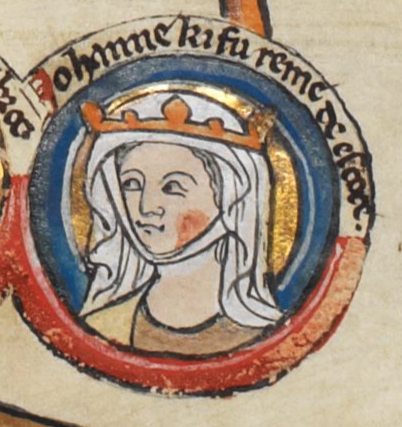by Susan Flantzer © Unofficial Royalty 2017

Credit – Wikipedia
The eldest of the three daughters and the third of the five children of King John of England and Isabella of Angoulême, Joan was born on July 22, 1210, in Gloucester, England.
Joan had four siblings:
- King Henry III of England (1207 – 1272), married Eleanor of Provence, had five children including King Edward I of England
- Richard, Earl of Cornwall, King of the Romans (1209 – 1272), married (1) Isabel Marshal, had three sons and a daughter, only one son survived childhood, Isabel died in childbirth (2) Sanchia of Provence, had two sons, only one son survived childhood (3) Beatrice of Falkenburg, no children
- Isabella of England (1214 – 1241), married Friedrich II, Holy Roman Emperor, had at least four children
- Eleanor of England (1215 – 1275), married (1) William Marshal, 2nd Earl of Pembroke, no children (2) Simon de Montfort, 6th Earl of Leicester, had seven children

13th-century depiction of King John and his children Henry, Richard, Isabella, Eleanor, and Joan; Credit – Wikipedia
Being the eldest daughter of a king, Joan soon had royal suitors vying for her hand in marriage. King Philip II of France wanted Joan as a bride for one of his sons, but in 1214, when Joan was four years old, King John promised Joan to Hugh X de Lusignan, Count of La Marche. When Joan’s mother Isabella of Angoulême was 12 years old, she was betrothed to the same Hugh X de Lusignan. This marriage would have joined La Marche and Angoulême, and the de Lusignan family would then control a vast, rich, and strategic territory between the two Plantagenet strongholds, Bordeaux and Poitier. To prevent this threat, King John of England decided to marry Isabella himself. Therefore, by promising his daughter in marriage to Hugh, King John was compensating Hugh for jilting him out of marrying Isabelle. In 1214, Joan was sent to be brought up at Hugh’s court until the marriage.
When she was six years old, Joan’s father King John died on October 18, 1216, leaving his eldest son Henry, a nine-year-old, to inherit his throne in the midst of the First Barons’ War (1215–17), in which a group of rebellious barons supported by a French army, made war on King John because of his refusal to accept and abide by the Magna Carta. In July of 1217, Joan’s mother Isabella left her son, King Henry III of England, in the care of his regent, William Marshal, 1st Earl of Pembroke, and returned to France to assume control of her inheritance, the County of Angoulême. There, Isabella once again met her jilted fiancé Hugh de Lusignan, now the 10th Count of La Marche. Upon seeing Isabella once again, Hugh decided that he preferred Joan’s still-beautiful mother over her daughter. Isabella and Hugh married on May 10, 1220, and on May 15, 1220, Joan was sent back to England where negotiations for a marriage with Alexander II, King of Scots took place.
Great Seal of Alexander II, King of Scots; Credit – Wikipedia
Twelve years older than Joan, Alexander II, King of Scots was the only son of William I, King of Scots (the Lion), and had become King of Scots in 1214 when he was sixteen years old. On June 21, 1221, at York Minster in York, England, eleven-year-old Joan married 23-year-old Alexander. Alexander’s court was dominated by his mother Dowager Queen Ermengarde and therefore, Joan’s position was not strong. Joan and Alexander never had any children, which left Alexander without an heir, a major issue for any king. An annulment of the marriage was risky as it could provoke a war with England.
Joan accompanied her husband to York, England in September 1237 for talks with her brother King Henry III of England regarding the borders between Scotland and England. In York, Joan and her sister-in-law Eleanor of Provence agreed to make a pilgrimage to Thomas Becket’s shrine in Canterbury. The contemporary chronicler Matthew Paris suggests that Joan and Alexander had become estranged and that Joan wished to spend more time in England. While in England, Joan became ill and died in the arms of her brothers King Henry III and Richard, Earl of Cornwall at Havering-atte-Bower, near London, England on March 4, 1238, at the age of 27. At her request, Joan was buried at Tarrant Abbey in Tarrant Crawford, Dorset, England. In 1252, King Henry III ordered “an image of our sister” to be made and set over her tomb, but no trace of the tomb exists. It is thought that Joan is now buried, supposedly in a golden coffin, in the graveyard of St. Mary the Virgin Church, an unused church, and all that remains of Tarrant Abbey.

St. Mary the Virgin Church; Photo Credit – By ChurchCrawler, CC BY-SA 2.0, https://commons.wikimedia.org/w/index.php?curid=9186803
This article is the intellectual property of Unofficial Royalty and is NOT TO BE COPIED, EDITED, OR POSTED IN ANY FORM ON ANOTHER WEBSITE under any circumstances. It is permissible to use a link that directs to Unofficial Royalty.
Works Cited
“Alexander II of Scotland.” Wikipedia. N.p.: Wikimedia Foundation, 29 Dec. 2016. Web. 31 Dec. 2016.
“Joan of England, queen of Scotland.” Wikipedia. N.p.: Wikimedia Foundation, 30 Oct. 2016. Web. 31 Dec. 2016.
Susan. “Isabella of Angoulême, queen of England.” British Royals. Unofficial Royalty, 23 Aug. 2016. Web. 31 Dec. 2016.
Williamson, David. Brewer’s British Royalty. London: Cassell, 1996. Print.
